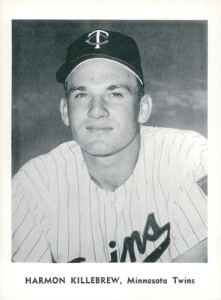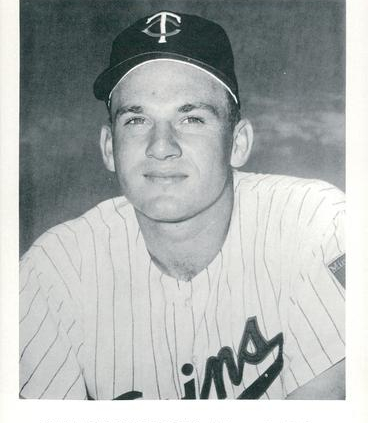August 10, 1971: Harmon Killebrew ends home run drought by joining 500 club
 Minnesota Twins slugger Harmon Killebrew was in an unusual home-run slump and appeared to leverage a late-season exhibition game and related home-run derby to get back on track. In dramatic fashion on the next day against the Baltimore Orioles, he slammed his 500th and 501st home runs to join an elite group of nine players who had previously attained this milestone.
Minnesota Twins slugger Harmon Killebrew was in an unusual home-run slump and appeared to leverage a late-season exhibition game and related home-run derby to get back on track. In dramatic fashion on the next day against the Baltimore Orioles, he slammed his 500th and 501st home runs to join an elite group of nine players who had previously attained this milestone.
The 35-year-old Killebrew had averaged nearly 40 home runs a season from 1959, his first season as a regular starter, through 1970. He had acquired his nickname, Killer, for good reason. During that period, he had hit more home runs (476) than anyone in the majors. (Hank Aaron was next with 452.) Killebrew had hit 11 home runs in five partial seasons prior to 1959 and, with 487 in his career through 1970, was closing in on the milestone. However, the 1971 season was uncharacteristic for him; he hit only 12 home runs through August 8. He had been without a homer in his previous 13 games (the last on July 25) and had only one in his last 36 games. For a feared hitter like Killebrew, his performance amounted to a season-long slump to that point.
While he remained at number 498 for a little over a month, Killebrew began to feel the tension of reaching the next milestone, because the Twins announced that commemorative mugs would be handed out to fans on July 6. They were predicting he would have reached 500 by then. But that didn’t happen because Killebrew suffered a sprained right big toe and sat out several games. The Twins gave out the mugs anyway.1
Everyone was weighing in on why Killebrew couldn’t break out of his drought. Twins owner Calvin Griffith offered, “Nobody can tell me it wasn’t because of the pressure. Harmon had to be thinking about that. It is only natural that a man thinks about it, especially since everyone is talking about it.”2
Killebrew acknowledged that he had felt the added pressure during the previous weeks, noting that every interview he conducted included questions about when he would finally achieve the milestone.3
On August 9 the Twins played a rare exhibition game during the regular season, against the San Francisco Giants. A home-run derby was staged before the game between Killebrew and Giants slugger Willie Mays, who had played with the Triple-A Minneapolis Millers in 1951. With each batter getting 15 fair balls, Mays outhit Killebrew in homers, 6-4. However, Killebrew also hit a homer during the game in which the Twins won, 5-2.4 It turned out that the event served as a warm-up for Killebrew’s next regular-season game, the following day.
The banter around the home-run derby contest centered on who was in the best position to chase Babe Ruth’s home-run record. The 40-year-old Mays, who was in second place behind Ruth, suggested that Henry Aaron was the favorite to challenge the record. Killebrew said of his own case, “I’m just thinking about No. 13 this year, not Ruth’s 714.”5
The Twins began a three-game series with the Baltimore Orioles on August 10 with a night game at Metropolitan Stadium. The defending World Series champion Orioles held first place in the American League East Division with a 5½-game lead over Boston coming into the game, while the Twins were mired in fifth place in the AL West, 19½ games behind Oakland. The season’s performance was a huge setback for the Twins, who had won their division in the previous two seasons.
The Twins’ Tom Hall and the Orioles’ Mike Cuellar drew the starting-pitcher assignments. Left-hander Cuellar had 13 wins, headlining a staff that included Jim Palmer, Dave McNally, and Pat Dobson. (Each would finish the season with 20 or more wins.) Hall was a part-time starter for the Twins, with four wins to his credit.
It had been two weeks since Killebrew’s 499th home run, so it was a jubilant moment when he broke the slump in the bottom of the first with a solo home run to left field off Cuellar. Twins coach Frank Crosetti gave him a celebratory handshake as he rounded third base amid cheering fans who were aware of the significance of his hit. His teammates swarmed him as he arrived in the dugout, and they insisted that he take a bow in front of the crowd before teammate Tony Oliva stepped in the batter’s box as the next hitter.6
The Orioles retaliated the next inning when Davey Johnson smacked a double scoring Boog Powell. Catcher Andy Etchebarren followed with a single that drove in a run to take the Orioles to a 2-1 lead.
The Orioles added a run in the third inning on Brooks Robinson’s single off Hall that scored Merv Rettenmund, who had singled and gone to second on Frank Robinson’s groundout.
The score remained 3-1 until Killebrew tied the score in the bottom of the sixth with his second home run off Cuellar. Cesar Tovar, who had singled, also scored.
Ray Corbin relieved Hall in the top of the eighth, while Cuellar was still in the game with the game tied after nine innings. Corbin yielded a leadoff solo home run to Rettenmund in the top of the tenth. Cuellar held the Twins scoreless in the bottom half to cinch the Orioles’ 4-3 win.
In recording his ninth complete game of the season, Cuellar gave up seven hits and struck out five. Aside from the two round-trippers by Killebrew, he was in control of the rest of the game. Corbin took his ninth loss of the season. Twins pitchers gave up 11 hits and struck out seven. Etchebarren was the hitting star for the Orioles with two doubles and a single.
After the game Killebrew remembered some of the memorable home runs along his journey to 500. He said, “I remember the first homer I ever hit in the American League, when I was with Washington. It was Billy Hoeft of Detroit in 1955. There are other stickouts, like the one I hit over the roof at Detroit in 1962 off Jim Bunning, but most of the other homers become fuzzy in memory. I’ll remember the one tonight.”7 Killebrew hit his 100th against the White Sox’ Early Wynn in 1961, his 200th against Washington’s Jim Duckworth in 1963, his 300th against the Yankees’ Bob Friend in 1966, and his 400th against the White Sox’ Gary Peters in 1969.
An oddity from Killebrew’s milestone game was that umpire Bill Kunkel, who was behind the plate, had served up three home runs to Killebrew when he was pitching for the Kansas City A’s in 1961.
Killebrew swapped an autographed Twins team baseball for the 500th home-run ball, which was caught by a fan. The fan was also invited to sit in the Twins owner’s box for the balance of the game.8
President Richard Nixon made a congratulatory phone call to Killebrew days later. In lieu of an autographed baseball, Nixon offered to send personalized golf balls “guaranteed for a hole-in-one.” Killebrew recalled that when he played for the Senators, Nixon, then the vice president, frequently attended Senators games.9
During his last 44 games of the season, Killebrew improved his home-run rate by hitting 14 for a season total of 28, still well below his average. He led the American League with 119 runs batted in. The season marked the beginning of a decline in his home-run output that continued over the next four seasons until he retired in 1975.
Killebrew finished his career with 573 home runs, fifth on the all-time list at the time. As of 2020 he was 12th on the list. During the 17 seasons (out of 22 total seasons) in which he was a regular starter, he led the American League in home runs in six seasons and finished in the top five in six other seasons. He was elected to the Baseball Hall of Fame in 1984.
The Twins finished fifth in the West Division in 1971 after having won the division in the previous two seasons. They wouldn’t return to the postseason until 1987, when they won their first-ever World Series.
Sources
In addition to the sources cited in the Notes, the author consulted Baseball-Reference.com and the following:
Lamey, Mark. “Killebrew Reaches Elite Class With 500th Home Run,” The Sporting News, August 28, 1971: 33.
Notes
1 Bob Fowler. “Tension Broken – Killer Connects for 500th,” The Sporting News, August 28, 1971: 7.
2 Steve Aschburner. Harmon Killebrew: Ultimate Slugger (Chicago: Triumph Books, 2012), 132.
3 Tom Briere. “Harmon Hits 500 and 501,” Minneapolis Star Tribune, August 11, 1971: 1C.
4 Tom Briere. “Mays Wins Homer Duel, but Killebrew Saves One for Game,” Minneapolis Star Tribune, August 10, 1971: 1C.
5 Briere. “Mays wins homer duel.”
6 Tom Briere. “Harmon Hits 500 and 501.”
7 Briere. “Harmon Hits 500 and 501”: 2C.
8 Jim Elliott, “Twins Bow to Orioles in 10th, 4-3,” Baltimore Sun, August 11, 1971: C4.
9 “Nixon Calls to Salute Killer for His 500 Feat,” The Sporting News, August 28, 1971: 7.
Additional Stats
Baltimore Orioles 4
Minnesota Twins 3
Metropolitan Stadium
Bloomington, MN
Box Score + PBP:
Corrections? Additions?
If you can help us improve this game story, contact us.


